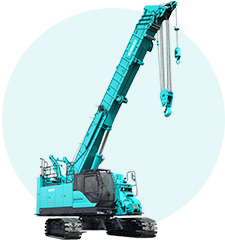In 2017, the company released its new 75t class TK750G, adding a new model in the TK-G series. The model featured Kobelco’s crane technology, maintaining the conventional solid structure and power, achieving the smallest transportation width of less than 2.99 m. The model proved ideal for basic construction work and also as a support machine for such work.
In June 2018, there was the long-awaited appearance of the 55t class TK550G which inherited the concept of the series. In addition to the firm structure that is the characteristic of the TK series, the model featured a combination of high transportability and assembly. About one year after the introduction of the TK750G, this machine responded to the market needs that differed from the field of the 75t, garnering attention as a machine that maximizes mobility in narrow worksites including city construction work.
Tackling and resolving a jigsaw puzzle of complex issues
TK750G, which was developed prior to the TK550G, maintained the attractive features of the conventional TK series while clearing the 2014 exhaust regulations. Moreover, by achieving a compact body with the smallest transportation width of 2.99 m, it eliminated the need to file for a “special vehicle traffic permit” for trailer transportation. Eliminating the complex paperwork and the lead time to obtain the permit itself resolved the issue of operational time loss.
 Shortened by 0.1 m compared with conventional machines, the model has a 3.7m turning radius of rear tail. With the crawler retracted, the body width is at its smallest 2.99 m, allowing it to self-mobilize into narrow construction sites.
Shortened by 0.1 m compared with conventional machines, the model has a 3.7m turning radius of rear tail. With the crawler retracted, the body width is at its smallest 2.99 m, allowing it to self-mobilize into narrow construction sites.
For the development of the TK550G, the basic concept remained the same; add value such as transportability, while succeeding conventional features for operating in severe construction sites centering on basic construction work. However, the development did not simply involve scaling down from 75t to 55t. Engaged in the formation of the development concept from a marketing viewpoint—transmitting market needs into development division—Yuya Morimoto recalls the significance of developing the new 55t class model.
However, all of them would not be possible unless the team could make the machine more compact and lightweight, while maintaining the strength and power of conventional machines. In short, they were asked for the simultaneous resolution of a three-way deadlock: rigidity, size and weight. The development project leader, Toru Nakazawa looked back on the situation.
Applying the “user hands-on approach” which only Kobelco would be capable of
Kobelco Construction Machinery has consistently adhered to serving “user hands-on approach”. This was reflected at every turn in this development project. For example, construction sites around cities are located in narrow areas, providing little space for assembly. Standing on the front line of service on a daily basis, Yuki Kitamura had caught the needs in the field and was sure that there was high demand for the TK550G in the outset of the project.
In addition, the rear tail of the body was shortened this time, reducing turning radius to 3.7 m. Shortening the rear portion required a small and heavy counterweight, which was resolved with filling materials. This further accelerated mobility at the construction work.
The spirit of valuing the convenience and operability of operators in the field is also shown in the winch’s tuning. Mitsuaki Iguchi, a hydraulics professional, showed his strength in this field.
Creating a superior product through communication and collaboration between divisions
The members of the TK550G development team were young, and gathered from various fields. According to Takafumi Kubo, who was involved in the field of machine design, said “The seriousness of responsibility promoted the growth of each individual in the development team.”
The TK550G was also equipped with a toolbox for storing work tools and maintenance parts. To create this toolbox, 2 m width was presumed, allowing the box to be horizontally laid when loaded on a transportation truck. A full-scale model of the box was made of cardboard and many opinions were gathered from various individuals. Taking into consideration convenience as well as the rigidity when the lid was opened, the lid was structured at a 1:2 division. A quite openness corporate climate made it possible for young members to work without anxiety and promote these detailed functions.
 A toolbox for storing maintenance tools and accessory parts. To ensure convenience and rigidity, the lid is separated into two parts.
A toolbox for storing maintenance tools and accessory parts. To ensure convenience and rigidity, the lid is separated into two parts.
Nakazawa, who was the project leader, also focused his efforts on maintaining an environment that would allow each individual to concentrate on development. Normally, for example, the respective developer is engaged in the various examinations throughout the development process from drawing up examination points, watching over the examination itself to handling the final analysis. Needless to say, this process was quite a burden for an individual.
The TK550G was born on a development stance of responding to customer’s needs by placing value on the voice from the field and a corporate culture of “creating a superior product” supported by teamwork beyond departments. This combination resulted in the birth of this outstanding Kobelco Construction Machinery product. The company has received excellent evaluations from customers who did a test drive of the machine. They have provided opinions such as “smooth movement seems possible even in small limited spaces” or “applications are likely to grow with the use of items such as the optional winch.” As construction demands grow in urban areas, the TK-G series will be more widely used by customers.
 Development members gathering in front of a TK550G prior to shipment. The group was formed by young members who would be responsible for future development projects.
Development members gathering in front of a TK550G prior to shipment. The group was formed by young members who would be responsible for future development projects.
The appeal of the TK series
* The contents described above is based on the information at the time of issuing (January, 2019).









Morimoto
The TK550G did not just feature the smallest transportation width. With the crawler retracted, the smallest width was also 2.99 m, allowing to enter narrow construction sites on its own power. With the Tokyo Olympics in 2020, redevelopment business in the urban areas are likely to continue, and several narrow construction sites are expected. That means there are plenty of opportunities for the TK550G which is even more compact than conventional machines. The vehicle width may have become smaller, but the number of opportunities is growing even larger.